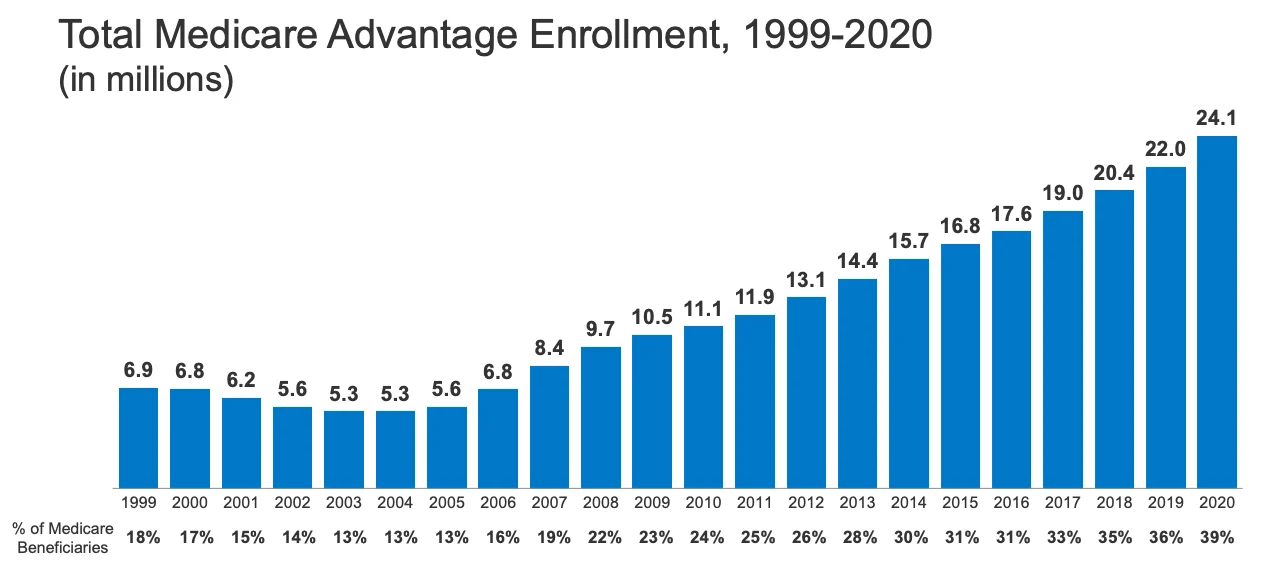
If the age distribution of the Medicare population had remained the same from 2007 to 2015, Medicare spending levels would have been slightly higher in later years than what was observed with the influx of baby boomers. SNPs restrict enrollment to specific types of beneficiaries with significant or relatively specialized care needs, or who qualify because they are eligible for both Medicare and Medicaid. The majority of SNP enrollees (88%) are in plans for beneficiaries dually eligible for Medicare and Medicaid (D-SNPs)
Increasing prices of health care services, increasing volume and utilization of services, and new technologies. In the past, provider payment reforms, such as the hospital prospective payment system, have helped to limit the growth in Medicare spending. Here at Century Medicare, we go over how the population affects the Medicare program.
Medicare provides coverage of basic health services including care in hospitals and other settings, physician services, diagnostic tests, and preventive services, and, as of 2006, also includes an outpatient prescription drug benefit offered through private plans. However, gaps in coverage and potentially high out-of-pocket costs are a growing concern.
Medicare generally does not pay for costs associated with long-term care, which can be prohibitively expensive, nor for dental care, vision, or hearing. The traditional fee-for-service Medicare program does not have an annual cap on out-of-pocket spending and the drug benefit has a significant gap in coverage before catastrophic coverage begins.
Medicare beneficiaries have the option to get their benefits through the traditional fee-for-service (FFS) program – sometimes called Original Medicare – or through private health plans, such as health maintenance organizations (HMOs) and preferred provider organizations (PPOs) – currently called Medicare Advantage. Under traditional FFS Medicare, beneficiaries can choose to be treated by virtually any hospital or doctor, while enrolling in a Medicare Advantage plan typically requires treatment from providers in a network, or paying a higher fee to receive care from an out-of-network provider.
Medicare Advantage plans generally provide all benefits covered under traditional Medicare, but many plans offer additional benefits. Today, most Medicare beneficiaries are covered under FFS Medicare, although the number of enrollees in private Medicare Advantage plans has risen dramatically in recent years, now totaling more than 10 million of Medicare’s 45 million beneficiaries.
In addition, as of 2006, Medicare beneficiaries have access to subsidized prescription drug coverage offered through private plans, either stand-alone prescription drug plans or Medicare Advantage plans.
Medicare is an insurance program. Medical bills are paid from trust funds which those covered have paid into. It serves people over 65 primarily, whatever their income; and serves younger disabled people and dialysis patients. Patients pay part of costs through deductibles for hospitals and other costs. Small monthly premiums are required for non-hospital coverage. Medicare is a federal program. It is basically the same everywhere in the United States and is run by the Centers for Medicare & Medicaid Services, an agency of the federal government.
Medicaid is an assistance program. It serves low-income people of every age. Patients usually pay no part of costs for covered medical expenses. A small co-payment is sometimes required. Medicaid is a federal-state program. It varies from state to state. It is run by state and local governments within federal guidelines. To see if you qualify for your state's Medicaid (or Children's Health Insurance) program.
Hospitals, clinics, and community health agencies can be very different from other work environments. health care systems are complex and there are many things you need to know about types of hospital systems, patient care, insurance, healthcare providers, and legal issues. This tutorial will help you learn basic healthcare concepts so you can be successful on the job and understand the system. Some of these approaches were judged to be ineffective or inconclusive in controlling the escalation in health care spending.
Annual increases in health care costs are placing upward pressure on Medicare spending, as for other payers. Government experts warn that by 2019, there will be insufficient funds in the Medicare Part A (Hospital Insurance)
In addition, Medicare law allowed almost 80% of all Medicare beneficiaries 65 and older to qualify under the HI program. Between July 30 1965 and August 31 1966, a total of 19.2 million people enrolled into Medicare's HI program during that period. The vast majority were automatically eligible for hospital coverage because they were Social Security pension cash recipients. This special interim measure covers the remaining ageing population — roughly 2 million.
In 1972, major amendments to the Social Security Act extended Medicare coverage to disabled people under the age of 65 receiving Social Security and railroad retirement benefits due to disability. The Social Security Agency reported that the years 1966 to 1972 the disability population used more health care services with fewer private health insurances compared to the uninsured.
Medicare currently provides health insurance to almost all 65-year-old Americans and over. In 1984, 13 percent of all Medicare-enrolled adults were over age 60. Because of increasing health insurance coverage for older individuals a recommendation has been made for Medicare to be increased by 50 or 70 years. Most people working at least until age 60 could get health insurance on the job. In many retiree cases, private coverage can be obtained by acquiring it before age 67 or later.
A frequent question arose from the lengthy legislative discussion that followed the passing of Medicare, which centered about the lack of medical insurance for the elderly. In a survey conducted by the United States government from 1963 until Medicare, it was revealed that only 63 percent of people 65 or older had medical insurance. The elderly are the main determinants of health, having the highest rate of illness and the lowest incomes. Medicare became law as part of the Title XVII Social Security Act.
If you have any questions or concerns about how the population affects the medicare program feel free to contact us today.